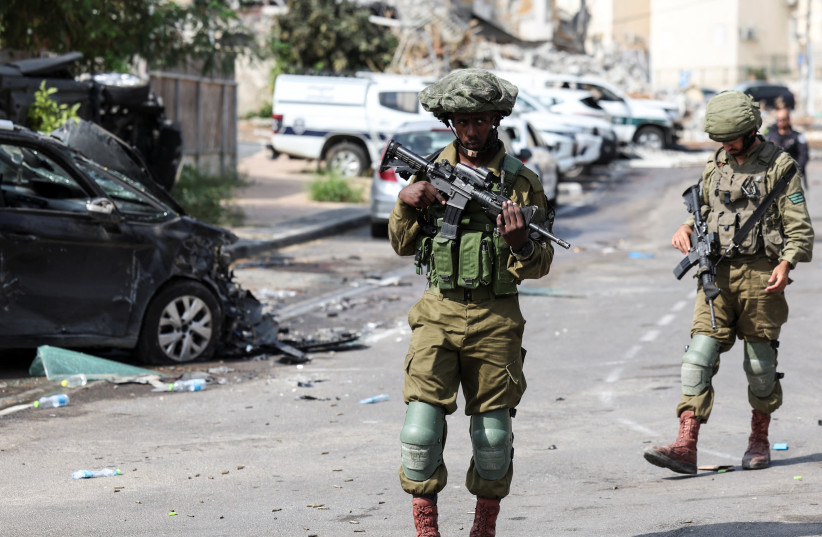The second day of the war with Hamas in Gaza began with Israel hitting back, with the IAF striking buildings in Gaza, while near Zikim, the army targeted five terrorists hiding nearby, later taking out two others near Zikim beach.
I drove down to the Gaza border on Sunday as operations continued inside Israel against Hamas terrorists who had infiltrated on Saturday and massacred hundreds. The full details of the disaster are slowly emerging, with the stories told by survivors growing more harrowing by the hour.
The roads heading south toward Ashkelon, and from Ashkelon to the border communities, were largely deserted, as security forces began clearing the border towns, including Urim, Be’eri, Nahal Oz, Netiv Ha’asara, and Zikim.
The remnants of Saturday’s fighting were strewn everywhere. On one of the roads that runs parallel to the Strip, near Karmiya and toward Zikim, several cars lay abandoned, some struck by bullets, one whose engine was still running. Bodies lay along the road as well, some covered with blankets, with some still exposed to the hot sun.
While the area had been mostly secured by Israeli forces overnight, the extent of the tragedy was slowly becoming clear. Terrorists had infiltrated from Gaza and threatened 22 of these border communities; most of the remaining members of which were leaving, driving in the opposite direction.

Others were delivering supplies. A truck driver bringing a generator asked for directions, as several foreign workers on bicycles crossed a street in the distance.
This is an agricultural area whose sites and workers are usually active in the fields. But on Sunday, a quiet had descended, with the only noise being a few tanks churning up a gravel road, spreading dust into the distance. Explosions could be heard in Gaza from airstrikes carried out by the IDF, as well as the sounds of outgoing artillery and tank fire.
Terrorists continued to fire rockets at the border communities, setting off sirens. But the massive barrage of some 2,000 rockets the day before had dwindled to intermittent fire.
Along the border, there was a sense of unease because so much of the civilian life here had come to a stop with the massacres that took place in those communities. Many of them were founded many decades ago: Yad Mordechai in 1936, Zikim in 1949, Karmia in 1950, and Netiv Ha’asara in 1982.
Traveling this lonely road – now a road of death – was a trip back along the history of Israel, because some of the first Jewish communities here were founded before the state, the most recent ones in the 1980s. The two communities founded in 1949 and 1950 had seen threats from infiltration since the founding of the state. However, the attack on October 7 was unprecedented.
Shock on the border
There was a sense of shock along the border. This area has seen fighting many times, but now it felt like the border area was unsettled in a way not seen in the past.
The contrast to the sense of loss could be felt among the IDF tanks that were deployed now in the area. The hulking metal beasts now provided security and a sense of power, deploying an iron hand, ready to be clenched into a fist. On one road a tank created a small traffic jam, as some civilians leaving the area and two men in a rental car tried to drive around the war machine, its massive cannon stretched across the road. Eventually, the rental car gave up and turned around and a police escort helped the civilian traffic get around the tank. They were going to safety, under the watchful eyes of the Merkava and its veteran crew.
The second day of the war has brought some changes along the border. The evacuation of civilians means that many of these communities will remain empty witnesses to the memories of the Hamas massacres that took place at 29 infiltration points along the border.
The rising death toll stretches beyond 700 and thousands are wounded; the full extent of what happened remains to be known. But what is clear is that the old paradigm of fighting wars here has changed for good.
The IDF has deployed in these areas before, tanks have churned up the melon fields before, and the dunes have seen terrorist infiltration in the past. But the extent of the terrorist destruction and the infiltrations is unprecedented, as was the total failure of Israel’s vaunted intelligence apparatus to anticipate the surprise attack – on the 50th anniversary of the surprise attack that launched the Yom Kippur War! – and alert the necessary forces to engage with the enemy and check its advance.
Day two of the war provided a sense that something has changed on the border. Will civilian life return to these communities? Can life ever be the same after these events?
